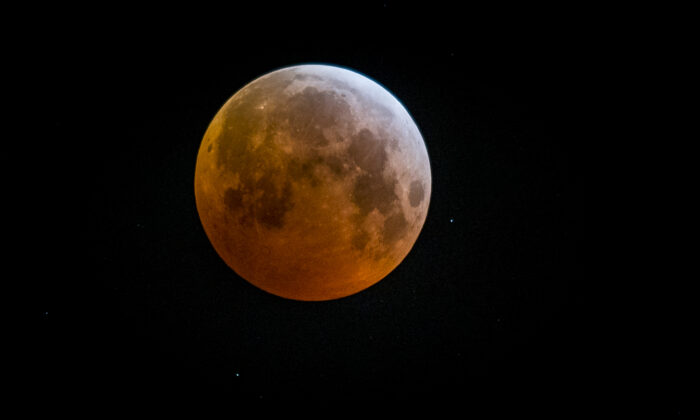
An illustration picture shows a total lunar eclipse and blood moon over the sky in Mechelen, Belgium, on Jan. 21, 2019. (Jasper Jacobs/AFP via Getty Images)
By
A total lunar eclipse known as a “blood moon” will appear around the world on Tuesday, Nov. 8, coming hours after polls open across the United States for the midterm elections.
The space phenomenon will be visible to viewers in North America, Central America, Asia, Australia, some Pacific islands, and in portions of South America. In the United States, the eclipse will start Tuesday at 3:02 a.m. ET or 12:02 a.m. PT, according to NASA’s website.
At that time, NASA says on its website, the “Moon enters the Earth’s penumbra, the outer part of the shadow. The Moon begins to dim, but the effect is quite subtle.” The total lunar eclipse will start at around 5:17 a.m. ET or 2:17 a.m. PT, the website adds.
That’s when “the entire Moon is now in the Earth’s umbra,” according to NASA. “The Moon will turn a coppery-red. Try binoculars or a telescope for a better view. If you want to take a photo, use a camera on a tripod with exposures of at least several seconds.”
After the eclipse on Tuesday, the next total lunar eclipse won’t occur again for another three years, or March 14, 2025, NASA noted.
“You will be able to see the entire eclipse unfold before sunrise, weather permitting, as the moon exits the dark part of Earth’s shadow, called the umbra,” NASA says of Tuesday’s event.
It’s the first total lunar eclipse on Election Day in U.S. history.
“It’s a wonderful reminder of this really special connection between the Earth, the moon, and the sun,” said Noah Petro, a scientist with the Lunar Reconnaissance Orbiter Project at NASA in a Washington Post interview. “Every eclipse is special because they’re all wonderful opportunities to go out and look at the moon, our nearest neighbor in space.”
A faint penumbra lunar eclipse will occur on May 5 and May 6 of 2023, according to Petro. A partial lunar eclipse will also occur on Oct. 28 of next year.
“Every eclipse is special because they’re all wonderful opportunities to go out and look at the moon, our nearest neighbor in space,” Petro told the paper.
The occurrence of a blood-colored moon has been recorded for thousands of years and has been mentioned in ancient Chinese history as well as in the Old Testament. In a notable example, a red-colored moon was seen during the fall of Constantinople in 1453 AD when the Ottomans finally took over the capital of the Byzantine Empire.